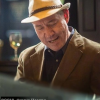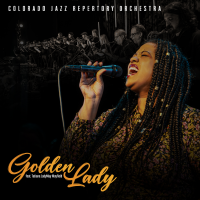Home » Jazz Articles » Live Review » Miles Electric Band at SFJAZZ
Miles Electric Band at SFJAZZ
SFJAZZ
San Francisco, CA
August 23, 2014
"This is not a ghost band—just a great group of musicians who loved playing with Miles and had admiration for the Chief." —Miles Electric Band leader Vincent Wilburn, Jr.
Many who first became interested in jazz in the 1970s will remember an album which came to stores at the commencement of that glorious decade. An affordably priced, two-LP set, it came with an exotic cover containing two gleaming black discs, with red centers sporting serif text encircled by the then familiar Columbia Records logo. That album was Bitches Brew (1970) the late, legendary jazz trumpeter Miles Davis' first venture into electronic, rock and funk-influenced music.
That tradition, begun within those early (and later) bands, highlighted many of today's most successful and best known performers: Keith Jarrett, Herbie Hancock, John McLaughlin, Chick Corea, Jack DeJohnette, Wayne Shorter, Al Foster, Joe Zawinul and Dave Holland, among others.
Love fusion or loathe it, the jazz world has never been the same since. Following his demise, there have been a few efforts to reinterpret Davis' work in this genre. The latest is the Miles Electric Band, an improvisatory ensemble led by Davis' nephew, drummer Vincent Wilburn, Jr. He brings together a variety of musicians; while some have played with Davis, others are younger, talented players.
A rare opportunity to see the band came when a 12-member version of this dynamic ensemble came to the SFJazz Center in San Francisco. Accomplished electronic artists (DJ Logic on turntables, Jeremy Ellis on electronics, electric bassist Darryl Jones and guitarist Blackbyrd McKnight) faced off with acoustic virtuosos (Debasish Chaudhuri on tabla and Abbas Kosimov on percussion), as trumpeter Etienne Charles and alto saxophonist Antoine Roney took center-stage, while svelte and lyrical percussionist Munyungo Jackson and Wilburn, Jr.—David alum, both— held down the backbeat in the rear. Rounding out this formidable ensemble, John Beasley commanded the keyboards and synthesizer stage left, while another Davis alum, Robert Irving III, played keyboards stage right.
How well did the acoustic partner with the über-electronic? Quite well, largely because generous solo times were allotted to the musicians. Chaudhuri—clad in a saffron top and ornate, pristine white lungi—took the spotlight and offered an accomplished, mesmerizing konnakol vocal during the set-opening "Right Off," from Davis' A Tribute to Jack Johnson (Columbia, 1971), the ensemble veering into some classic Davis funk at its conclusion.
Charles, a talented Trinidadian man-on-the-horn---clad in a straw hat and black-and-white, ornately checked trousers—had Davis' trumpet licks nailed. McKnight, wearing sunglasses and sporting long grey dreadlocks, held down the grooves.
Zawinul's title track to In a Silent Way (Columbia, 1969)—one of Davis' best known electric-era tunes—followed, blossoming as Charles came in with a lovely, muted solo and Jackson added swirling, subtle percussive effects. Featuring Roney's lovely soprano sax solo, Wayne Shorter's "Nefertiti" came next, segueing into Bitches Brew's lyrical "Spanish Key."
A highlight of the evening came when, during "Miles Runs the Voodoo Down," Jackson moved to centre stage and seated himself on a cajón—the box-like percussion instrument invented by Afro Peruvians—dueting with Chaudhuri on tabla and jumping up with a flourish at the end.
Later, during Shorter's "Sanctuary," Kosimov's turn to solo arrived, captivating the audience on traditional Tajik instruments—the doyra (a frame drum, also variously referred to as dayereh, dojra, dajre, doira, and dajreja) and the qayroq, a set of exotic castanets. Producing tones resembling galloping horses, Kosimov twirled this frame drum, tossed it in in the air, circled it with his finger as if it were a frisbee and then, still holding it, let loose with one qayroq in each hand. Jones, known for his work with Davis, Sting and The Rolling Stones, followed with a powerful solo.
During "Jean Pierre," Beasley weighed in with synthesizer tones, while DJ Logic's turntable and Ellis' electronics added complexity to the mix. Despite a standing ovation coupled with wild audience enthusiasm, Wilburn announced that one of the musicians had to make a Red Eye flight, so that was it for the evening and the crowd filed out.
Tags
Miles Electric Band
Live Reviews
Harry S. Pariser
United States
California
san francisco
Miles Davis
Keith Jarrett
Herbie Hancock
john mclaughlin
Chick Corea
Jack DeJohnette
Wayne Shorter
Al Foster
Joe Zawinul
Dave Holland
DJ Logic
Darryl Jones
Etienne Charles
Antoine Roney
Munyungo Jackson
John Beasley
Robert Irving III
Sting
The Rolling Stones
PREVIOUS / NEXT
Support All About Jazz
 All About Jazz has been a pillar of jazz since 1995, championing it as an art form and, more importantly, supporting the musicians who make it. Our enduring commitment has made "AAJ" one of the most culturally important websites of its kind, read by hundreds of thousands of fans, musicians and industry figures every month.
All About Jazz has been a pillar of jazz since 1995, championing it as an art form and, more importantly, supporting the musicians who make it. Our enduring commitment has made "AAJ" one of the most culturally important websites of its kind, read by hundreds of thousands of fans, musicians and industry figures every month.





























